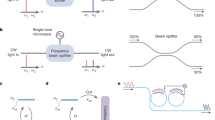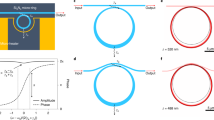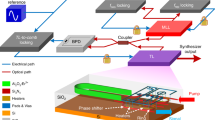Abstract
Modern systems often provide complex functionality that can be realized by tailoring together elements of simpler functionality. Multiplicity of simple optical functions (response shapes), when densely fabricated on a chip, can promote the concept of a field-programmable optical array. Shaping of the frequency response, or otherwise an electrical-to-optical response, is studied and demonstrated by means of a racetrack-shaped ring resonator designed and fabricated in the so-called double injection configuration. This configuration possesses a unique property that allows two free spectral range states (regular, 2 × regular) to exist for a single ring length. Shaping is realized by properly selecting different coupling coefficients that provide a variety of interesting responses. Here, we demonstrate various shapes including: sinusoidal, triangular (linear), square (bandpass), dips and peaks (two states), spikes (tangent-like), interleaver and a so-called 20dB-min parameters-insensitive-response modulator. The transmission responses were experimentally realized, fabricated in a silicon-on-insulator platform and characterized at wavelengths around 1,550 nm.
This is a preview of subscription content, access via your institution
Access options
Access Nature and 54 other Nature Portfolio journals
Get Nature+, our best-value online-access subscription
$29.99 / 30 days
cancel any time
Subscribe to this journal
Receive 12 print issues and online access
$209.00 per year
only $17.42 per issue
Buy this article
- Purchase on Springer Link
- Instant access to full article PDF
Prices may be subject to local taxes which are calculated during checkout





Similar content being viewed by others
Data availability
The data that support the plots within this paper and other findings of this study are available from the corresponding authors upon reasonable request.
References
Subbaraman, H. et al. Recent advances in silicon-based passive and active optical interconnects. Opt. Express 23, 1744–1746 (2015).
Grillanda, S. et al. Non-invasive monitoring of mode-division multiplexed channels on a silicon photonic chip. J. Light. Technol. 33, 1197–1201 (2015).
Ackert, J. J. et al. High-speed detection at two micrometres with monolithic silicon photodiodes. Nat. Photon. 9, 393–396 (2015).
Khan, M. H. et al. Ultrabroad-bandwidth arbitrary radiofrequency waveform generation with a silicon photonic chip-based spectral shaper. Nat. Photon. 4, 117–122 (2010).
Marpaung, D. et al. Integrated microwave photonics. Laser Photon. Rev. 7, 506–538 (2013).
Zhuang, L., Roeloffzen, C. G. H., Hoekman, M., Boller, K.-J. & Lowery, A. J. Programmable photonic signal processor chip for radiofrequency applications. Optica 2, 854–859 (2015).
Cox, C. H., Ackerman, E. & Betts , G. E., & Prince, J. L. Limits on the performance of RF-over-fiber links and their impact on device design. IEEE Trans. Microw. Theory Tech. 54, 906–921 (2006).
Ehrlichman, Y., Amrani, O. & Ruschin, S. Electro-optic threshold comparator based on multimode interference. Opt. Express 21, 72–73 (2013).
Chen, P., Chen, S., Guan, X., Shi, Y. & Dai, D. High-order microring resonators with bent couplers for a box-like filter response. Opt. Lett. 39, 6304–6307 (2014).
Wang, Q. & He, S. Optimal design of a flat-top interleaver based on cascaded M–Z interferometers by using a genetic algorithm. Opt. Commun. 224, 229–236 (2003).
Song, J. et al. Passive ring-assisted Mach–Zehnder interleaver on silicon-on-insulator. Opt. Express 16, 8359–8365 (2008).
Bridges, W. & Schaffner, J. Distortion in linearized electrooptic modulators. IEEE Trans. Microw. Theory Tech. 33, 2184–2197 (1995).
Dingel, B., Madamopoulos, N., Prescod, A. & Madabhushi, R. Analytical model, analysis and parameter optimization of a super linear electro-optic modulator (SFDR>130 dB). Opt. Commun. 284, 5578–5587 (2011).
Gutierrez, A. & Galan, J. High linear ring-assisted MZI electro-optic silicon modulators suitable for radio-over-fiber applications. In 9th International Conference on Group IV Photonics (GFP) 57–59 (IEEE, 2012).
Cardenas, J., Morton, P. & Khurgin, J. Linearized silicon modulator based on a ring assisted Mach Zehnder inteferometer. Opt. Express 21, 13115–13122 (2013).
Chi, H. & Yao, J. A photonic analog-to-digital conversion scheme using Mach–Zehnder modulators with identical half-wave voltages. Opt. Express 16, 567–572 (2008).
Tait, A. N., Shastri, B. J., Fok, M. P., Nahmias, M. A. & Prucnal, P. R. The DREAM: An integrated photonic thresholder. J. Light. Technol. 31, 1263–1272 (2013).
Zhang, Z., Huang, B., Zhang, Z., Cheng, C. & Chen, H. Microwave photonic filter with reconfigurable and tunable bandpass response using integrated optical signal processor based on microring resonator. Opt. Eng. 52, 127102 (2013).
Cherchi, M. et al. Flat-top interleavers: a novel approach based on MMI splitters. Proc. SPIE 9752, 975210 (2016).
Zhuang, L. et al. Sub-GHz-resolution C-band Nyquist-filtering interleaver on a high-index-contrast photonic integrated circuit. Opt. Express 24, 5715–5727 (2016).
Akahane, Y., Asano, T., Song, B. & Noda, S. High-Q photonic nanocavity in a two-dimensional photonic crystal. Nature 425, 944–947 (2003).
Zhang, L. et al. Embedded ring resonators for microphotonic applications. Opt. Lett. 33, 1978–1980 (2008).
Qiu, C. et al. Asymmetric Fano resonance in eye-like microring system. Appl. Phys. Lett. 101, 021110 (2012).
Souza, M. C. M. M. et al. Embedded coupled microrings with high-finesse and close-spaced resonances for optical signal processing. Opt. Express 22, 20179–20186 (2014).
Bogaerts, W. et al. Silicon-on-insulator spectral filters fabricated with CMOS technology. IEEE J. Sel. Top. Quantum Electron. 16, 33–44 (2010).
Cohen, R. A., Amrani, O. & Ruschin, S. Linearized electro-optic racetrack modulator based on double injection method in silicon. Opt. Express 23, 2252–2261 (2015).
Darcie, T. E., Zhang, J., Driessen, P. F., Member, S. & Eun, J. Class-B microwave-photonic link using optical frequency modulation and linear frequency discriminators. J. Light. Technol. 25, 157–164 (2007).
Iezekiel, S. Class AB. radio-over-fiber link based on highly linear ring resonator modulators. Proc. SPIE 9387, 938709 (2015).
Pérez, D. et al. Multipurpose silicon photonics signal processor core. Nat. Commun. 8, 636 (2017).
Zhang, W. & Yao, J. A fully reconfigurable waveguide Bragg grating for programmable photonic signal processing. Nat. Commun. 9, 1396 (2018).
Yariv, A. Universal relations for coupling of optical power between microresonators and dielectric waveguides. Electron. Lett. 36, 321–322 (2000).
Prinzen, A., Waldow, M. & Kurz, H. Fabrication tolerances of SOI based directional couplers and ring resonators.Opt. Express 21, 17212–17220 (2013).
Zhang, Y. et al. A compact and low loss Y-junction for submicron silicon waveguide. Opt. Express 21, 1310–1316 (2013).
Xiao, Z. et al. Ultra-compact low loss polarization insensitive silicon waveguide splitter. Opt. Express 21, 16331–16336 (2013).
Ding, J., Ji, R., Zhang, L. & Yang, L. Electro-optical response analysis of a 40 Gb/s silicon Mach–Zehnder optical modulator. J. Light. Technol. 31, 2434–2440 (2013).
Yue, P., Yi, X., Li, Q.-N., Wang, T. & Liu, Z.-J. MMI-based ultra linear electro-optic modulator with high output RF gain. Optik 124, 2623–2626 (2013).
Khilo, A., Sorace, C. M. & Kärtner, F. X. Broadband linearized silicon modulator. Opt. Express 19, 4485–4500 (2011).
Author information
Authors and Affiliations
Contributions
R.A.C. conceived the idea and simulated the optical and electro-optical circuits, fabricated the devices as well as designed and performed the experiments and also analysed the results and wrote the manuscript. O.A. and S.R. conceived the idea, analysed the results, contributed to manuscript preparation and supervised the study.
Corresponding authors
Ethics declarations
Competing interests
The authors declare no competing interests.
Additional information
Publisher’s note: Springer Nature remains neutral with regard to jurisdictional claims in published maps and institutional affiliations.
Rights and permissions
About this article
Cite this article
Cohen, R.A., Amrani, O. & Ruschin, S. Response shaping with a silicon ring resonator via double injection. Nature Photon 12, 706–712 (2018). https://doi.org/10.1038/s41566-018-0275-4
Received:
Accepted:
Published:
Issue Date:
DOI: https://doi.org/10.1038/s41566-018-0275-4
This article is cited by
-
Programmable wavelength filter with double ring loaded MZI
Scientific Reports (2022)
-
Ultrahigh dynamic range and low noise figure programmable integrated microwave photonic filter
Nature Communications (2022)
-
Fano Resonance Using Surface Plasmon Polaritons in a Nano-disk Resonator Coupled to Perpendicular Waveguides for Amplitude Modulation Applications
Plasmonics (2021)
-
Double injection resonator
Nature Photonics (2018)



